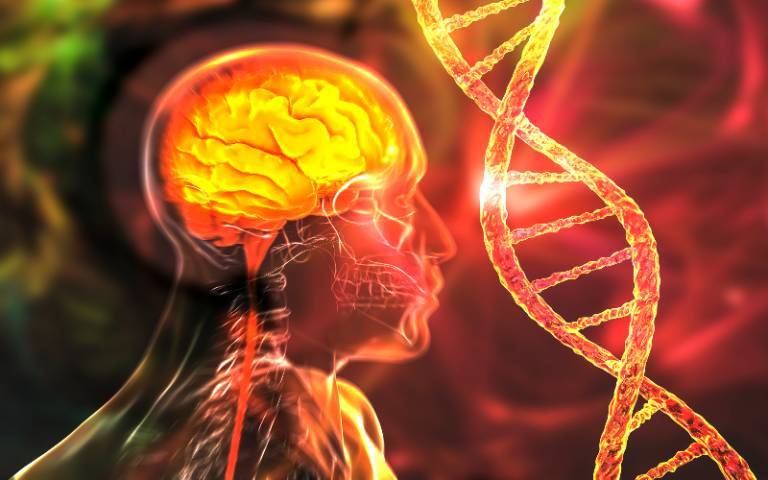Calls to assess neurological symptoms of rare genetic disorder
14 December 2023
Neurological signs and symptoms of the different subgroups of a rare condition, called xeroderma pigmentosum (XP), have been systematically characterised for the first time by researchers at the UCL Ataxia Centre and the UK National Xeroderma Pigmentosum Service.

XP is a group of rare genetic disorders, affecting around 120 people in the UK, in which patients are not able to repair the damage in their DNA caused by ultraviolet radiation (UVR). Consequently, they are hyper-sensitive to sunlight and can develop exaggerated sunburn upon minimal sun exposure from an early age.
This chronic DNA damage causes symptoms such as lentigines (freckle-like spots on the skin), and multiple skin cancer and ocular issues. Some cases also develop neurological symptoms that impact patients’ quality of life, and that can be an important cause of morbidity and mortality over time.
Across the world, the condition is usually managed by dermatologists and the only preventative treatment available is meticulous photoprotection – such as minimising exposure to sunlight, wearing sunscreen, protective clothing and adapting environments (for example, using UVR protective window film).
However, the new research, published in Brain, found that nearly 40% of patients with XP develop neurological problems, including spinocerebellar ataxia which leads to difficulties with balance, speech, and a lack of coordination in the limbs. It also leads to cognitive decline, such as learning disability or dementia. These symptoms can affect the patient’s ability to live independently and, in some cases, contribute to their mortality.
The researchers systematically examined all eight subtypes of XP and enrolled them in a natural history study with the largest cohort of XP patients under long-term multidisciplinary care. They then characterised the neurological symptoms and signs in each group. They also studied how these symptoms progressed over time in the patients.
To do this they used the Scale for the Assessment and Rating of Ataxia (SARA), which assesses the patient’s gait, coordination and speech, - and the Activities of Daily Living questionnaire (ADL), which evaluates patient’s ability to perform actions like feeding, self-care, mobility, speech and swallowing.
They found that patients with the most severe XP genetic variants progressed faster in these scores for some of the groups. In addition, they also found mild neurological signs in some groups of XP traditionally considered free of neurological features.
In the UK, patients with XP are usually referred to a national service funded by NHS England dedicated to these very rare disorders, where patients are assessed by a multidisciplinary team. However, this is not the case in most other countries.
Consequently, the researchers are calling for all patients with XP to receive periodical neurological assessments as part of their treatment. They also highlight the importance of monitoring the symptoms of patients with spinocerebellar ataxia, as they could be used to help inform clinical outcomes in future clinical trials for patients with XP.
Lead author, Dr Hector Garcia-Moreno (UCL Ataxia Centre, Queen Square Institute of Neurology), said: “The results from this study illustrate the complexity of the neurological disease in XP, which can be an unrecognised and dismissed aspect of the condition in certain settings.
“However, we know from patients and their families that the neurological symptoms considerably impact their lives, and they are not optimally managed.”
Corresponding author, Professor Paola Giunti (Head of UCL Ataxia Centre, Queen Square Institute of Neurology, and Guy’s and St Thomas’ NHS Foundation Trust), said: “Our work clearly established that the XP neurological phenotype is characterised as a spinocerebellar ataxia. In establishing the protocol for the Natural History of XP we have been able to measure the progression with rating scales.
“The results of our project highlight that we can now look at these tools for clinical trial design, even in ultrarare diseases.”
The scales used in the study are already validated for other conditions with ataxia and are used for clinical trials and natural history studies.
Co-author, Dr Hiva Fassihi (Head of the UK National Xeroderma Pigmentosum Service at Guy’s and St Thomas’ NHS Foundation Trust) said: “The work led by Professor Paola Giunti at our multidisciplinary clinic highlights the importance of comprehensive phenotyping and correlation of this to the genotype in rare genetic diseases. The team has built a dedicated database to carefully document the neurology phenotype in XP, a condition generally under-recognised by neurologists.”
The team hope that their research will lead to possibilities for new treatment and therapeutic drug options for patients in the future.
Links
- Garcia-Moreno, et al. Neurological disease in xeroderma pigmentosum: prospective cohort study of its features and progression, Brain, Volume 146, Issue 12, December 2023, Pages 5044–5059, https://doi.org/10.1093/brain/awad266
- Dr Hector Garcia-Moreno's academic profile
- Professor Paola Giunti's academic profile
- Ataxia Centre, UCL Queen Square Institute of Neurology
Image
- Credit: Dr_Microbe on iStock
 Close
Close

